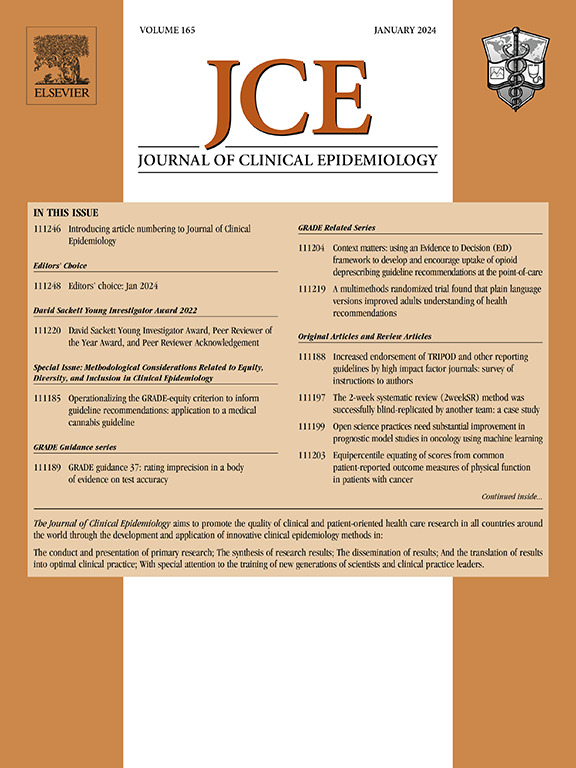Poor sample size reporting quality and insufficient sample size in economic evaluations conducted alongside pragmatic trials: a cross-sectional survey
IF 7.3
2区 医学
Q1 HEALTH CARE SCIENCES & SERVICES
引用次数: 0
Abstract
Objectives
Economic evaluations based on well-designed and -conducted pragmatic randomized controlled trials (pRCTs) can provide valuable evidence on the cost-effectiveness of interventions, enhancing the relevance and applicability of findings to healthcare decision-making. However, economic evaluation outcomes are seldom taken into consideration during the process of sample size calculation in pragmatic trials. The reporting quality of sample size and information on its calculation in economic evaluations that are well-suited to pRCTs remain unknown. This study aims to assess the reporting quality of sample size and estimate the power values of economic evaluations in pRCTs.
Study Design and Setting
We conducted a cross-sectional survey using data of pRCTs available from PubMed and OVID from 1 January 2010 to 24 April 2022. Two groups of independent reviewers identified articles; three groups of reviewers each extracted the data. Descriptive statistics presented the general characteristics of included studies. Statistical power analyses were performed on clinical and economic outcomes with sufficient data.
Results
The electronic search identified 715 studies and 152 met the inclusion criteria. Of these, 26 were available for power analysis. Only 9 out of 152 trials (5.9%) considered economic outcomes when estimating sample size, and only one adjusted the sample size accordingly. Power values for trial-based economic evaluations and clinical trials ranged from 2.56% to 100% and 3.21%–100%, respectively. Regardless of the perspectives, in 14 out of the 26 studies (53.8%), the power values of economic evaluations for quality-adjusted life years (QALYs) were lower than those of clinical trials for primary endpoints (PEs). In 11 out of the 24 (45.8%) and in 8 out of the 13 (61.5%) studies, power values of economic evaluations for QALYs were lower than those of clinical trials for PEs from the healthcare and societal perspectives, respectively. Power values of economic evaluations for non-QALYs from the healthcare and societal perspectives were potentially higher than those of clinical trials in 3 out of the 4 studies (75%). The power values for economic outcomes in Q1 were not higher than those for other journal impact factor quartile categories.
Conclusion
Theoretically, pragmatic trials with concurrent economic evaluations can provide real-world evidence for healthcare decision makers. However, in pRCT-based economic evaluations, limited consideration, and inadequate reporting of sample-size calculations for economic outcomes could negatively affect the results’ reliability and generalisability. We thus recommend that future pragmatic trials with economic evaluations should report how sample sizes are determined or adjusted based on the economic outcomes in their protocols to enhance their transparency and evidence quality.
与实用性试验同时进行的经济评估中样本量报告质量差和样本量不足:横断面调查。
目的:在实用性试验的样本量计算过程中,很少考虑经济评价结果。适用于实用随机对照试验(pRCTs)的经济评价的样本量报告质量及其计算信息仍不为人知。本研究旨在评估随机对照试验中经济评价的样本量和效力:我们利用 PubMed 和 OVID 上 2010 年 1 月 1 日至 2022 年 4 月 24 日期间的 pRCT 数据进行了横向调查。两组独立审稿人对文章进行了鉴定;三组审稿人分别对数据进行了提取。描述性统计介绍了纳入研究的一般特征。对数据充分的临床和经济结果进行了统计功率分析:电子检索发现了 715 项研究;152 项符合纳入标准,其中 26 项可用于功率分析。152 项试验中只有 9 项(5.9%)在估算样本量时考虑了经济学结果,只有一项试验对样本量进行了相应调整。基于试验的经济评估和临床试验的功率值分别为 2.56% 至 100%、3.21% 至 100%。无论从哪个角度看,在 26 项研究中,有 14 项(53.8%)的质量调整生命年(QALYs)经济评价的功率值低于主要终点(PEs)临床试验的功率值。在 24 项研究中的 11 项(45.8%)和 13 项研究中的 8 项(61.5%)中,从医疗保健和社会角度来看,质量调整生命年的经济评价功率值分别低于质量调整生命年的临床试验功率值。在总共 4 项研究中,有 3 项研究(75%)从医疗保健和社会角度对非 QALYs 进行经济评估的功率值可能高于临床试验的功率值。第一季度的经济学结果功率值并没有明显高于其他期刊影响因子四分位类别的功率值:从理论上讲,同时进行经济评估的实用性试验可为医疗决策者提供真实世界的证据。然而,在基于 pRCT 的经济学评价中,对经济学结果样本大小计算的有限考虑和不充分报告可能会对结果的可靠性和可推广性产生负面影响。为避免根据研究结果做出误导性决策,我们建议未来开展经济学评价的实用性试验应在试验方案中报告如何根据经济学结果确定或调整样本大小,以提高试验的透明度和证据质量。
本文章由计算机程序翻译,如有差异,请以英文原文为准。
求助全文
约1分钟内获得全文
求助全文
来源期刊

Journal of Clinical Epidemiology
医学-公共卫生、环境卫生与职业卫生
CiteScore
12.00
自引率
6.90%
发文量
320
审稿时长
44 days
期刊介绍:
The Journal of Clinical Epidemiology strives to enhance the quality of clinical and patient-oriented healthcare research by advancing and applying innovative methods in conducting, presenting, synthesizing, disseminating, and translating research results into optimal clinical practice. Special emphasis is placed on training new generations of scientists and clinical practice leaders.
 求助内容:
求助内容: 应助结果提醒方式:
应助结果提醒方式:


